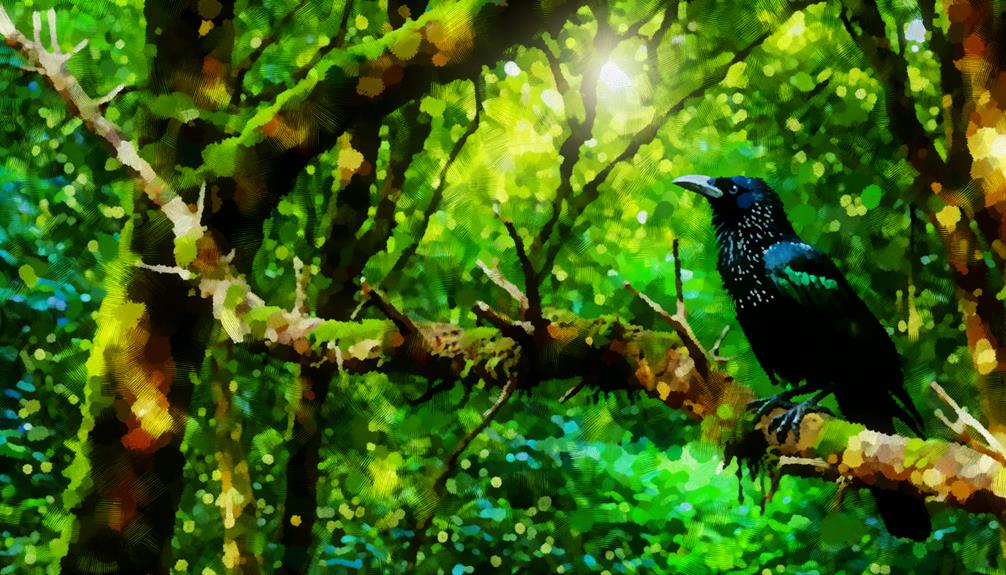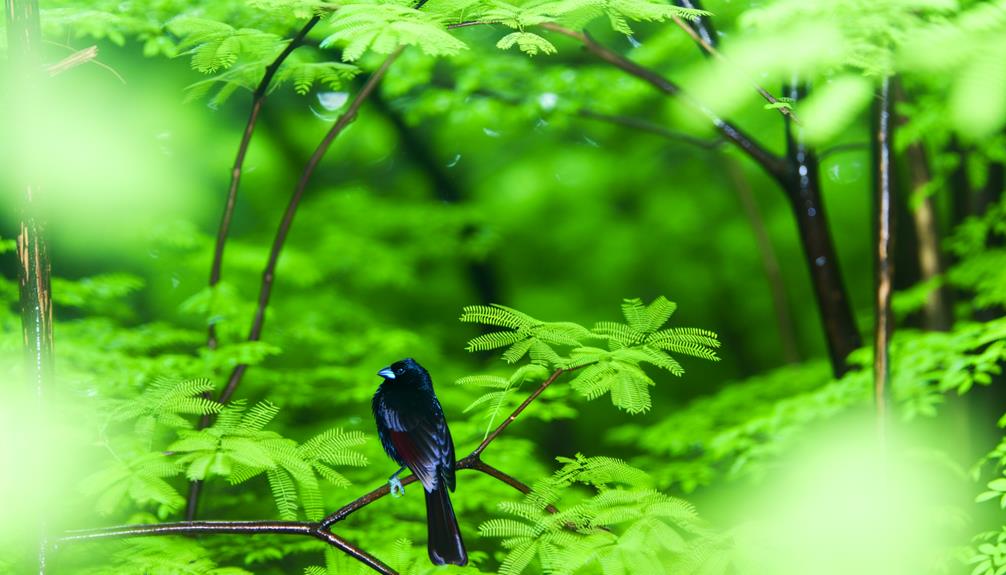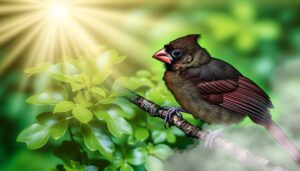Are There Myths and Realities About Black Cardinal Birds?
Regarding the query about black cardinal birds, there are no verified instances of such birds. Cardinals, part of the Cardinalidae family, typically exhibit vibrant red or brown plumage.
While genetic variations can cause deviations in coloration, melanism—characterized by an overproduction of melanin—has not been documented in cardinal populations. Melanism leads to darker pigmentation in various bird species via genes like MC1R, ASIP, and TYRP1, but similar genetic mutations in cardinals are unreported.
Misconceptions often arise, yet scientific evidence does not support the existence of black cardinals. For further insights into fascinating avian genetics and coloration patterns, continue on.

Key Takeaways
- True 'black cardinals' have not been verified through scientific observation or genetic analysis.
- Cardinal birds typically exhibit red or brown hues due to genetic and environmental factors.
- Melanism, causing dark plumage, is rare and not documented in cardinal birds.
- No genetic mutations specific to producing entirely black cardinals have been identified.
- Observational data and expert analysis confirm the absence of black cardinals in nature.
Cardinal Bird Overview

The Cardinalidae family, encompassing the cardinal birds, is characterized by robust, seed-eating passerines with strong, conical bills and vibrant plumage, mainly found in the Americas. These birds exhibit distinct sexual dimorphism, with males often displaying more vivid colors compared to females.
They inhabit diverse ecosystems, ranging from dense forests to suburban areas. Cardinals are primarily granivorous, relying on seeds for nutrition, though they also consume insects and fruits. Their nesting behavior involves constructing cup-shaped nests in shrubs or low trees.
Observational studies highlight their territorial nature, particularly during breeding seasons. Vocal communication is prominent, with varied songs and calls facilitating mate attraction and territory defense. Research underscores their adaptability to different environmental conditions.
Typical Cardinal Colors
Cardinal birds are mainly recognized for their vivid red plumage, a characteristic most commonly observed in male Northern Cardinals (Cardinalis cardinalis).
While the striking red coloration serves as a key identifier, variations such as leucistic or melanistic individuals occasionally appear, presenting unique deviations from the norm.
These rare color morphs provide valuable insights into the genetic diversity and environmental influences affecting this species.
Common Cardinal Colors
Displaying a striking contrast, common cardinal colors range from vibrant reds in males to subtler brownish hues in females, with each variation serving distinct evolutionary and ecological purposes.
Male cardinals exhibit flamboyant red plumage, which plays a critical role in courtship and territory defense.
Female cardinals, on the other hand, possess more cryptic coloration that aids in camouflage, enhancing survival during nesting.
- Sexual dimorphism: Males are vividly red, females are brownish with reddish tinges.
- Plumage function: Red coloration in males correlates with higher reproductive success.
- Camouflage benefits: Females' muted colors protect them from predators.
- Seasonal changes: Both sexes undergo molting, but color intensity varies seasonally.
These color distinctions are integral to the species' reproductive and survival strategies.
Rare Color Variations
While the common cardinal colors are well-documented, rare color variations such as yellow and leucistic cardinals offer fascinating insights into genetic mutations and environmental influences on avian pigmentation.
Yellow cardinals, for example, exhibit a genetic mutation affecting carotenoid metabolism, resulting in an unusual yellow plumage instead of the typical red.
Leucistic cardinals, on the other hand, display partial loss of pigmentation due to a genetic anomaly that disrupts melanin production, leading to white or pale feathers.
These rare occurrences provide valuable data for ornithologists studying the genetic diversity and adaptive mechanisms within bird populations.
Observations of these unique color variations underscore the complex interplay between genetics and environmental factors in shaping the appearance of avian species.
Genetic Variations in Cardinals

Recent studies have revealed a fascinating array of genetic variations among cardinal populations, contributing to their diverse phenotypic expressions. These variations are primarily responsible for the spectrum of coloration observed in these birds, ranging from the typical vibrant red to less common hues.
Scientific investigations have identified several genetic markers correlated with these color changes.
- Genetic mutations affecting pigment production
- Variation in carotenoid assimilation
- Influences of environmental factors on gene expression
- Potential hybridization with other bird species
Each of these factors plays a critical role in determining the coloration and overall appearance of cardinals.
Understanding these genetic nuances not only broadens our knowledge of cardinal biology but also aids in conservation and breeding programs aimed at preserving these avian wonders.
Melanism in Birds
Exploring the phenomenon of melanism in birds, which results from an overproduction of melanin pigments, offers further insight into the complex genetic mechanisms that govern avian coloration.
Melanism, a form of genetic mutation, leads to the darkening of feathers and is often observed across various avian species. Research has identified several genes involved, such as MC1R, ASIP, and TYRP1, which regulate melanin synthesis and distribution.
Empirical studies indicate that melanistic individuals might possess adaptive advantages, such as enhanced UV protection and camouflage. Detailed field observations and genetic analyses have revealed that these darkly pigmented birds may also exhibit variations in behavior and habitat preferences, contributing significantly to our understanding of avian biodiversity and evolutionary biology.
Black Bird Species

Among the myriad of avian species exhibiting melanistic traits, certain black bird species such as the Melanistic Northern Cardinal (Cardinalis cardinalis) provide compelling case studies for understanding the genetic and ecological implications of dark pigmentation in birds.
Melanism can occur across various taxa, influenced by genetic mutations, environmental pressures, and adaptive advantages.
Key observations include:
- Genetic Basis: Mutations in melanin-related genes can lead to increased dark pigmentation.
- Survival Advantages: Enhanced camouflage in specific habitats can provide survival benefits.
- Behavioral Aspects: Melanistic birds may exhibit altered behaviors due to visual signaling.
- Ecosystem Impact: The presence of melanistic individuals can affect predator-prey dynamics and community structures.
These factors underscore the complexity and significance of melanistic variations within avian populations.
Reported Black Cardinal Sightings
Numerous documented sightings of melanistic Northern Cardinals have emerged, providing valuable data for ornithologists studying the prevalence and distribution of this rare pigmentation variant. These observations have been reported across various regions, enhancing our understanding of this unusual phenomenon. Significantly, these sightings span a wide geographical range, offering insights into potential environmental or genetic factors influencing melanism in cardinal populations.
| Location | Date |
|---|---|
| Texas | March 2018 |
| Florida | June 2019 |
| Ohio | September 2020 |
| Georgia | February 2021 |
| North Carolina | July 2022 |
Such data is essential for building a detailed picture of the occurrence of melanistic cardinals, aiding in the formulation of hypotheses and guiding future research efforts in avian genetics and ecology.
Scientific Studies and Findings

Investigations into the phenomenon of black cardinal birds have revealed significant insights into genetic variability within the cardinal species.
Studies have documented cases of unusual bird coloration, linking these occurrences to specific genetic mutations and environmental factors.
Research methodologies have encompassed both field observations and advanced genetic analyses, yielding discoveries that contribute to our understanding of avian pigmentation anomalies.
Genetic Variability in Cardinals
Recent genetic studies have exposed significant variability within cardinal populations, shedding light on the evolutionary adaptations and phenotypic diversity observed in these birds.
Researchers have identified several genetic markers associated with distinct coloration patterns, behavioral traits, and physiological responses. This genetic diversity is essential for understanding the adaptability and resilience of cardinals to various environmental pressures.
- Genetic markers: Specific alleles linked to feather coloration variations.
- Adaptive significance: Correlation between genetic diversity and environmental adaptability.
- Behavioral genetics: Evidence of genetic influence on mating and territorial behaviors.
- Physiological adaptations: Genetic basis for differences in metabolic rates and stress responses.
These findings underscore the importance of genetic studies in revealing the complex mechanisms driving biodiversity within cardinal species.
Unusual Bird Coloration Cases
Building on the understanding of genetic variability, several scientific studies have documented unusual coloration cases in cardinal birds, providing fascinating insights into the genetic and environmental factors influencing avian pigmentation. These studies reveal that aberrations such as melanism, leucism, and xanthochroism can notably alter typical plumage. For instance, melanism results in an excess of dark pigmentation, sometimes producing black cardinal birds. Leucism involves partial loss of pigmentation, leading to white or pale plumage, while xanthochroism manifests as yellow instead of red.
| Condition | Description |
|---|---|
| Melanism | Excess dark pigmentation |
| Leucism | Partial loss of pigmentation |
| Xanthochroism | Yellow pigmentation instead of red |
These findings underscore the complexity of genetic interactions and environmental influences on avian coloration, illustrating the diverse manifestations within cardinal species.
Research Methodologies and Discoveries
Numerous scientific studies have employed advanced genetic sequencing, field observations, and controlled experiments to elucidate the mechanisms behind unusual pigmentation in cardinal birds. These efforts have revealed critical insights into the genetic and environmental factors influencing melanism in this species. Key discoveries include:
- Genetic Mutations: Identification of specific genetic mutations linked to increased melanin production.
- Environmental Influences: Examination of how diet and habitat contribute to pigmentation variations.
- Comparative Analysis: Cross-species comparisons to identify common genetic pathways in melanistic birds.
- Behavioral Studies: Observations on mating and survival advantages conferred by darker plumage.
These findings collectively advance our understanding of phenotypic diversity in cardinal birds, offering a thorough picture of the factors driving rare black coloration.
Expert Opinions
According to ornithologists specializing in avian coloration, the distinct pigmentation of black cardinal birds poses intriguing questions regarding genetic variations and evolutionary adaptations within the Cardinalidae family.
Experts hypothesize that melanism, an increased development of the dark-colored pigment melanin, may contribute to these pigmentation anomalies. Detailed observations have noted that such variations can arise from genetic mutations, potentially offering survival advantages such as enhanced camouflage or thermoregulation.
Moreover, studies suggest that these adaptations could be driven by environmental pressures or interspecies breeding, leading to phenotypic diversity. Evidence-based analyses also explore the role of epigenetic factors, which may alter gene expression without changing the underlying DNA sequence, thereby influencing coloration patterns in cardinal populations.
Photographic Evidence

Photographic evidence of black cardinal birds has been essential in documenting these rare sightings and capturing unique phenotypic variants. High-resolution images allow for detailed analysis of coloration patterns, aiding in the differentiation of potential genetic mutations or environmental factors influencing plumage.
Such visual documentation provides empirical data that supports ongoing scientific investigations into avian diversity and adaptation.
Rare Sightings Documented
Detailed observations and photographic evidence have documented rare sightings of black cardinal birds, shedding light on this unusual avian phenomenon. Such sightings are exceptionally rare and are often rigorously verified by ornithologists and birdwatching communities.
The occurrence of black cardinal birds is attributed to genetic mutations, such as melanism, which results in an overproduction of melanin.
- First documented sighting: A photograph taken in Pennsylvania in 2018.
- Confirmed locations: Sightings have been reported in the southeastern United States.
- Ornithological verification: Experts have validated the authenticity of these sightings through detailed morphological analysis.
- Public interest: These rare sightings have generated significant interest in ornithological circles and among amateur birdwatchers.
These documented instances contribute valuable data to ongoing studies of avian genetic variation.
Capturing Unique Variants
High-resolution images of black cardinal birds not only provide compelling evidence of their existence but also enable detailed morphological analyses that facilitate the study of this rare genetic mutation. Photographic documentation is essential for verifying the presence of these unique variants and distinguishing them from other melanistic species. Detailed observations from high-quality images allow ornithologists to examine feather structure, pigmentation patterns, and anatomical features, aiding in the understanding of the genetic mechanisms at play.
| Observation Aspect | Details |
|---|---|
| Feather Composition | Analysis of feather structure and density |
| Pigmentation Patterns | Distribution and intensity of black pigments |
| Anatomical Features | Beak shape, wing span, and tail length |
| Habitat Documentation | Geographic location and environmental setting |
| Behavioral Study | Feeding, mating, and nesting behaviors |
Such evidence-based approaches are vital in advancing our knowledge of avian genetic diversity.
Analyzing Bird Coloration
Frequently, ornithologists rely on photographic evidence to meticulously analyze the intricate coloration patterns of black cardinal birds, providing critical insights into the underlying genetic mutations. By capturing high-resolution images, researchers can document subtle variations in plumage that may not be discernible to the naked eye. This approach assists in identifying:
- Melanin deposition: Examining the distribution and concentration of melanin pigments.
- Feather structure: Analyzing microstructural changes that influence light reflection and absorption.
- Genetic markers: Correlating visual data with specific genetic sequences responsible for pigmentation.
- Environmental influences: Evaluating how habitat and diet impact coloration.
Such detailed observations are pivotal for understanding avian genetics and the evolution of unique phenotypic traits within the cardinal species.
Cardinal Bird Habitats
Cardinal birds mainly inhabit deciduous forests, dense thickets, and well-vegetated suburban areas, where they can find ample food sources and nesting sites. These habitats provide a diverse array of seeds, fruits, and insects—critical components of their diet.
Scientific observations indicate that cardinals prefer regions with dense foliage, which offers protection from predators and harsh weather conditions. Nesting typically occurs in shrubs or low tree branches, where the thick cover guarantees both concealment and accessibility.
Urban and suburban environments with bird feeders have also become increasingly significant, supporting cardinal populations by supplementing natural food sources. The adaptability of cardinals to various habitats underscores their resilience, although habitat destruction remains a pertinent threat to their long-term sustainability.
Myths and Misconceptions

Despite their lively presence and familiar calls, numerous myths and misconceptions about cardinal birds persist, often rooted in folklore rather than scientific evidence. These misconceptions can obscure our understanding of these fascinating creatures.
- Color Variations:
While cardinals are mainly red, occasional genetic mutations can lead to variations, but a true 'black cardinal' remains unverified by scientific literature.
- Behavioral Myths:
Some believe cardinals mate for life; however, research indicates that while they are generally monogamous, instances of mate-switching do occur.
- Migration Patterns:
Contrary to popular belief, cardinals are non-migratory, staying within their range year-round.
- Symbolism:
Cultural myths often ascribe cardinals with spiritual meanings, but these lack empirical support and should not be confused with biological facts.
Role of Environment
Environmental factors greatly influence the behavior, physiology, and distribution of cardinal birds, providing critical insights into their adaptive strategies and ecological roles. Variations in temperature, humidity, and availability of resources such as food and nesting sites dictate cardinal behaviors, including migration patterns and reproductive timings. These factors also impact plumage coloration due to dietary influences and genetic expression. For instance, high carotenoid intake can enhance the vibrancy of their red feathers, while environmental stressors might lead to alterations in their physical condition.
| Environmental Factor | Impact on Cardinals |
|---|---|
| Temperature | Affects migration and breeding |
| Humidity | Influences plumage maintenance |
| Food Availability | Determines health and coloration |
| Nesting Sites | Affects reproductive success |
| Environmental Stress | Alters physical and behavioral traits |
Understanding these interactions helps in conservation efforts and habitat management for cardinal populations.
Possibility of Black Cardinals

While environmental factors shape various aspects of cardinal life, they also raise intriguing questions about the potential existence of black cardinal birds. Scientific investigations, however, reveal no concrete evidence supporting the existence of melanistic cardinals, where an overproduction of melanin could result in black plumage.
Observational data primarily show cardinals in their characteristic red or brown hues, determined by genetic predispositions and dietary influences.
- Genetic mutation analysis: No recorded cases of melanism in Cardinalis cardinalis.
- Historical sightings: Lack of documented instances of black cardinals.
- Feather pigmentation studies: Consistent findings of red and brown coloration.
- Environmental impact assessment: No environmental factors identified that could induce melanism in cardinals.
These meticulously gathered data points emphasize the improbability of black cardinal birds.
Conclusion
To sum up, the concept of black cardinal birds, while fascinating, remains an extreme rarity. Typical cardinal plumage, resplendent in vivid reds and subtle browns, starkly contrasts with the elusive melanistic variation that could theoretically produce a black cardinal.
Melanism, though documented in avian species, has not been definitively observed in cardinals. The profound impact of genetic mutations and environmental factors underscores the improbability of such an occurrence, solidifying the traditional image of the cardinal in ornithological studies.






